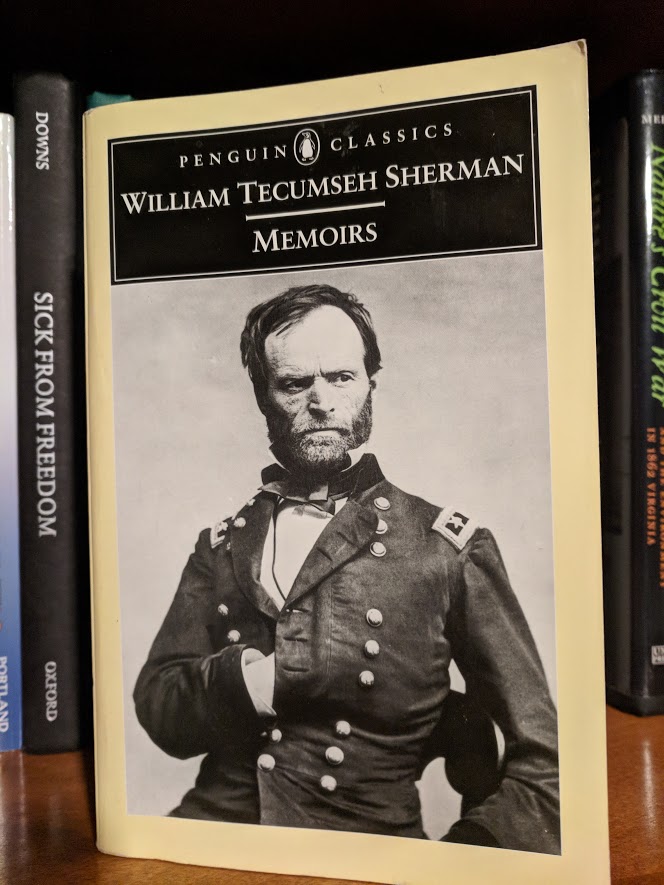C’mon, Cump!
 In his recent, admiring biography of William Tecumseh Sherman, Brian Holden Reid terms him a “dazzling literary stylist.”
In his recent, admiring biography of William Tecumseh Sherman, Brian Holden Reid terms him a “dazzling literary stylist.”
Well, watch out for that razzle-dazzle, at least in Sherman’s Memoirs (1875).
I am not the first to notice that in his recollections Cump glided through or omitted entirely stuff that didn’t make him look good.
The late, great Albert Castel, in fact, wrote an entire article on “Prevaricating Through Georgia: Sherman’s Memoirs as a Source on the Atlanta Campaign” (Civil War History, March 1994). One of the dozen-and-a-half items Dr. Castel accumulates to make his point concerns the battle of Pickett’s Mill. There, twenty-five miles northwest of Atlanta on May 27, 1864, Sherman pressed Maj. Gen. O. O. Howard to order a frontal attack on Pat Cleburne’s division, which was waiting for the Yankees to do that very thing. In two hours of repeated assaults, Brig. Gen. Thomas J. Wood’s division lost 212 killed, 927 wounded and 318 missing, for a total of 1,457 casualties (OR, vol. 38, pt. 1, 387). Cleburne’s troops, who easily repulsed each attack, sustained a loss of 85 killed and 363 wounded—they were fighting without entrenchments.
It was, as Castel notes, “the second bloodiest defeat experienced by the Union forces during the Atlanta.” But in his Memoirs Sherman provides not a single word about it. “It is as if it never occurred,” Albert resignedly shrugs. (See for yourself—vol. 2, pages 44-45.)
Rendering Sherman’s neglect more egregious is that Wood’s divisional loss at Pickett’s Mill was the largest single-battle casualty figure for any of Sherman’s infantry divisions during the entire Atlanta Campaign. After Wood’s 1,4578 on May 27, there’s Maj. Gen. Daniel Butterfield’s division at Resaca, May 14-15, whose loss was counted as 963 officers and men (38, 2, 324). Finally, in the three-hour series of charges launched by Sherman at Kennesaw Mountain, June 27, Brig. Gen. Jefferson C. Davis’ division suffered 824 casualties (third bloodiest by my count).
…or maybe not. Two days after the battle of New Hope Church, fought May 25 not too far from Pickett’s Mill, General Hooker reported Brig. Gen. Alpheus Williams’ division had lost 870 in the attack against Peter Stewart’s division (38, 2, 14). But a few months later, Williams stated that his loss had been 745—102 K, 639 W, 4 M (38, 2, 30).
But back to Cump. Even his veterans caught on to the way he ignored Pickett’s Mill, and they resented it. Here, from the National Tribune of Feb. 5, 1903:
There is something strange in the fact that not only in Gen. Sherman’s Memoirs but in most of the histories or accounts of the Atlanta Campaign, the Army of the Cumberland has never received full credit for its losses.
Stranger still, Gen. Sherman in his Memoirs makes no mention, nor does he seem to take into account, the losses of one of the bloodiest battles fought during the campaign—the battle of Pickett’s Mill, May 27. This battle was mainly fought by Gen. Wood’s Division of the Fourth Corps, and in no other battle during the campaign did any single division suffer as did Gen. Wood’s Division in the battle. It suffered almost as great a loss as did both Gen. Jeff. C. Davis’s and Gen. Newton’s Divisions in their celebrated charge on Kenesaw, just a month later. In this charge Davis’s Division lost 824, and Newton’s 654; total, 1,478.
Gen. Wood’s Division at Pickett’s Mill lost 1,457, only 21 less than both Davis and Newton at Kenesaw. Yet Gen. Sherman thought the conflict not worthy of mention.
Would that W. T. Sherman had been as scrupulous in relating history as B. A. Dunn proved himself to be. In other words, so much for “dazzling”; I’d settle for honest.
[Ed. note: This post is drawn by Steve Davis from his recent book, From Texas Brigadier to the Fall of Atlanta: John Bell Hood, published last year by Mercer University Press.]
I conducted a study of W. T. Sherman’s Shiloh reports years ago, and found them just as you describe: full of obfuscation, miss-direction, omission, time-compression (or time-expansion) as it suits.
“Don’t let the FACTS get in the way of a good story.”
And at Chattanooga he later gloats about taking a strategic hill. It was manned by a signal corp only. A bit later, he tried to take the actual objective and ran into Cleburne (it didn’t go well for him).
Yes, and that hill he mistook for Tunnel Hill was forever called ‘Billy Goat Hill’.
Col. Henry Boynton took him to task after Sherman published his memoirs.
H. V. Boynton: Sherman’s Historical Raid. The Memoirs in the Light of the Record. Cincinnati, OH: Wilstach, Baldwin & Co. 1875
Boynton had his own extreme bias and twisting of the truth.
Every autobiography or memoir is by nature the authors biased point of view. I’m not sure why Shermans would be expected to be more objective or historically comprehensive than any other.
Never a fan of Sherman. As much as he claimed to hate the press, he seemed to be forever checking his press clippings. And whereas Grant could put a spin on matters that embarrassed him, he at least wrote about them. As the post and others note, Uncle Bill completely ignored them. He was at best, like Stonewall, an indifferent tactition, who unlike Grant constantly seemed to want to avoid hard contact with the enemy. His strategic skills covered up more than a multitude of sins.
I’m going to suggest that Mr. Davis (and several others) has missed the point. The author said that Sherman was a “dazzling literary stylist,” which to me is not the same as “wonderfully accurate historian.” He (Reid) was complimenting Sherman as a wordsmith, that is all.
Great point… the term “spin doctor” would not be coined for another 125 years.